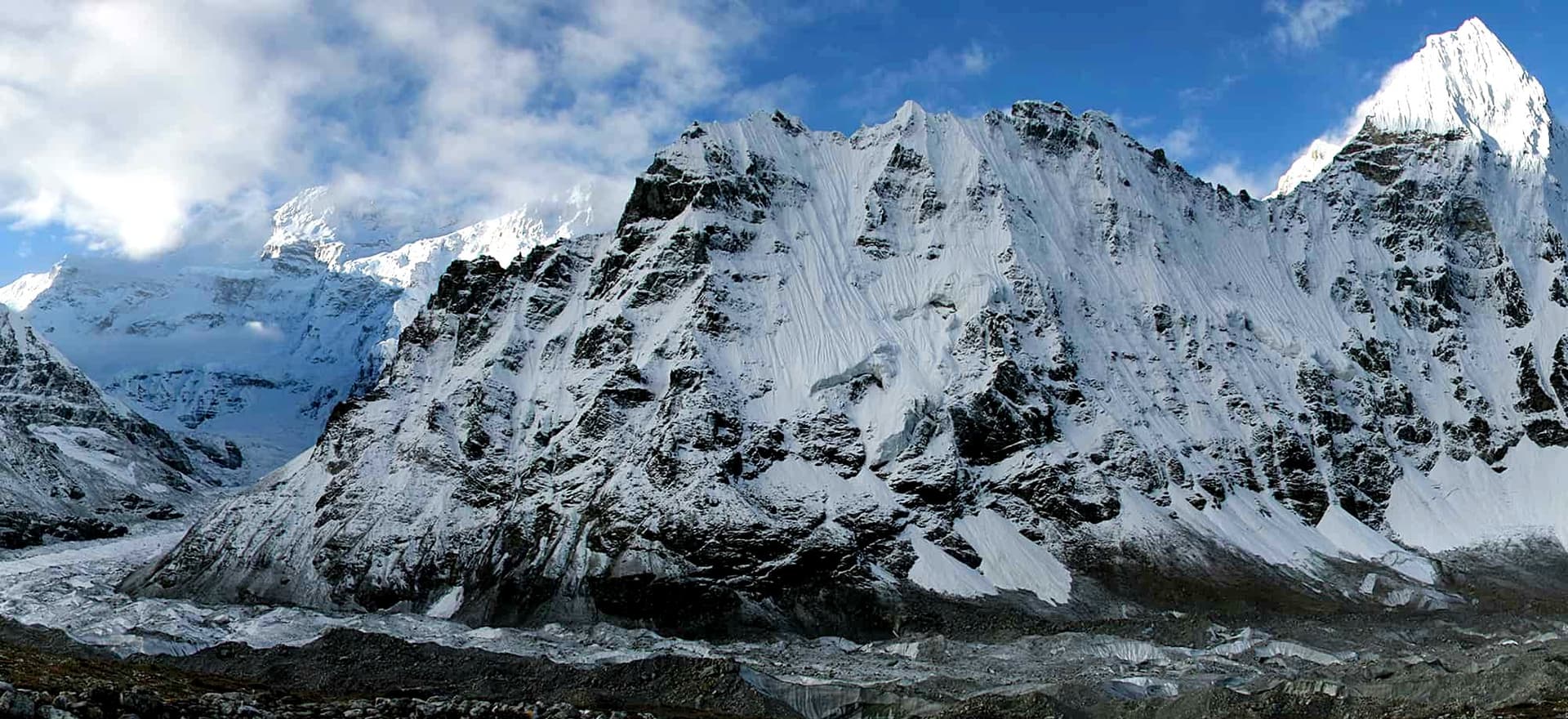For adventurers seeking to test their limits against some of the world’s most breathtaking landscapes, Nepal offers a roster of treks that are as challenging as they are rewarding. From the iconic heights of Everest Three Pass Trek to the remote wonders of the Upper Dolpo and Kanchenjunga Base Camp, these trails demand not only physical fitness but also mental resilience. Traversing rugged terrains, crossing high-altitude passes, and immersing in the rich cultural tapestry of the Himalayas, each trek presents a unique adventure. Whether it’s the secluded valleys of Manaslu and Nar Phu or the pristine environments of Makalu Base Camp, these journeys offer unparalleled opportunities to connect with nature and discover the endurance of the human spirit. Prepare for an experience that combines the thrill of adventure with the beauty of Nepal’s most challenging treks.

Luxury Holidays Nepal Pvt. Ltd. stands out for providing exceptional experiences on the Top 10 Challenging And Difficult Treks In Nepal. Offering tailored journeys that seamlessly blend adventure with comfort, our expertise ensures travelers explore the majestic landscapes of Nepal without compromising on luxury. From the Everest Three Pass to the remote corners of Upper Dolpo and Kanchenjunga, our curated treks are designed to meet the highest standards of safety, quality, and personalized service. Discover the unparalleled beauty of the Himalayas with Luxury Holidays Nepal, where every detail of your trek is crafted for an unforgettable adventure amidst nature's grandeur.
Three Passes Trek
The Everest Three Passes Trek is an exhilarating adventure that takes trekkers through some of the most spectacular landscapes in the Everest region of Nepal. This trek is designed for those who wish to explore the full beauty of the Everest area, including its high passes, remote valleys, and stunning views of the world's highest peaks.

Key Highlights:
- Starting Point: The journey typically begins with a scenic flight from Kathmandu to Lukla.
- Duration: Spanning over 18 to 22 days, this trek covers extensive ground, including three high mountain passes.
- Altitude: The trek crosses three high passes: Renjo La (5,360m), Cho La (5,420m), and Kongma La (5,535m), with an optional climb to Kala Patthar (5,545m) for a close-up view of Everest.
- Route: The route encompasses a wide range of landscapes, from the vibrant Sherpa heartland of Namche Bazaar to the tranquil Gokyo Lakes, the remote valleys near Thame, and the bustling hub of Gorak Shep.
- Difficulty Level: Considered challenging due to the high altitudes, long trekking days, and the physical demand of crossing the passes. Suitable for experienced trekkers with good physical fitness.
- Best Time to Visit: The ideal months are from March to May during the spring and from September to November in the autumn, offering clear weather and manageable temperatures.
What to Expect:
- Scenic Vistas: Panoramic views of Everest, Lhotse, Cho Oyu, and Makalu, among others.
- Varied Terrain: From lush valleys and dense forests to glacial moraines and high mountain passes.
- Cultural Richness: Insight into the life and traditions of the Sherpa people, visits to monasteries, and a chance to experience high-altitude Himalayan culture.
- Biodiversity: The region is known for its unique flora and fauna, including the chance to spot rare species like the snow leopard and red panda.
Preparation Tips:
- Physical Preparation: Engage in comprehensive cardio, strength, and endurance training at least six months prior to the trek.
- Gear and Equipment: Invest in quality trekking boots, thermal wear, a durable backpack, sleeping bags rated for cold weather, and essential safety equipment.
- Acclimatization: Plan for adequate acclimatization days in the itinerary to reduce the risk of altitude sickness.
- Guides/Porters: Hiring experienced guides and porters can enhance safety and provide valuable insights into the local culture and geography.
The Everest Three Passes Trek offers an unparalleled trekking experience that combines physical challenges with the awe-inspiring beauty of the Himalayas. It's a journey that rewards trekkers with a profound sense of achievement and memories that last a lifetime. Ideal for adventurers seeking to immerse themselves in the natural and cultural wonders of the Everest region, this trek is a testament to the grandeur of the Himalayas.
Upper Dolpo Trek
The Upper Dolpo Trek is an extraordinary journey into one of the most remote and untouched regions of Nepal, offering a rare glimpse into the ancient culture, stunning landscapes, and the traditional way of life that has remained largely unchanged for centuries. This trek delves deep into the hidden heart of the Dolpo region, a land of mystic beauty, rugged terrain, and vibrant culture.
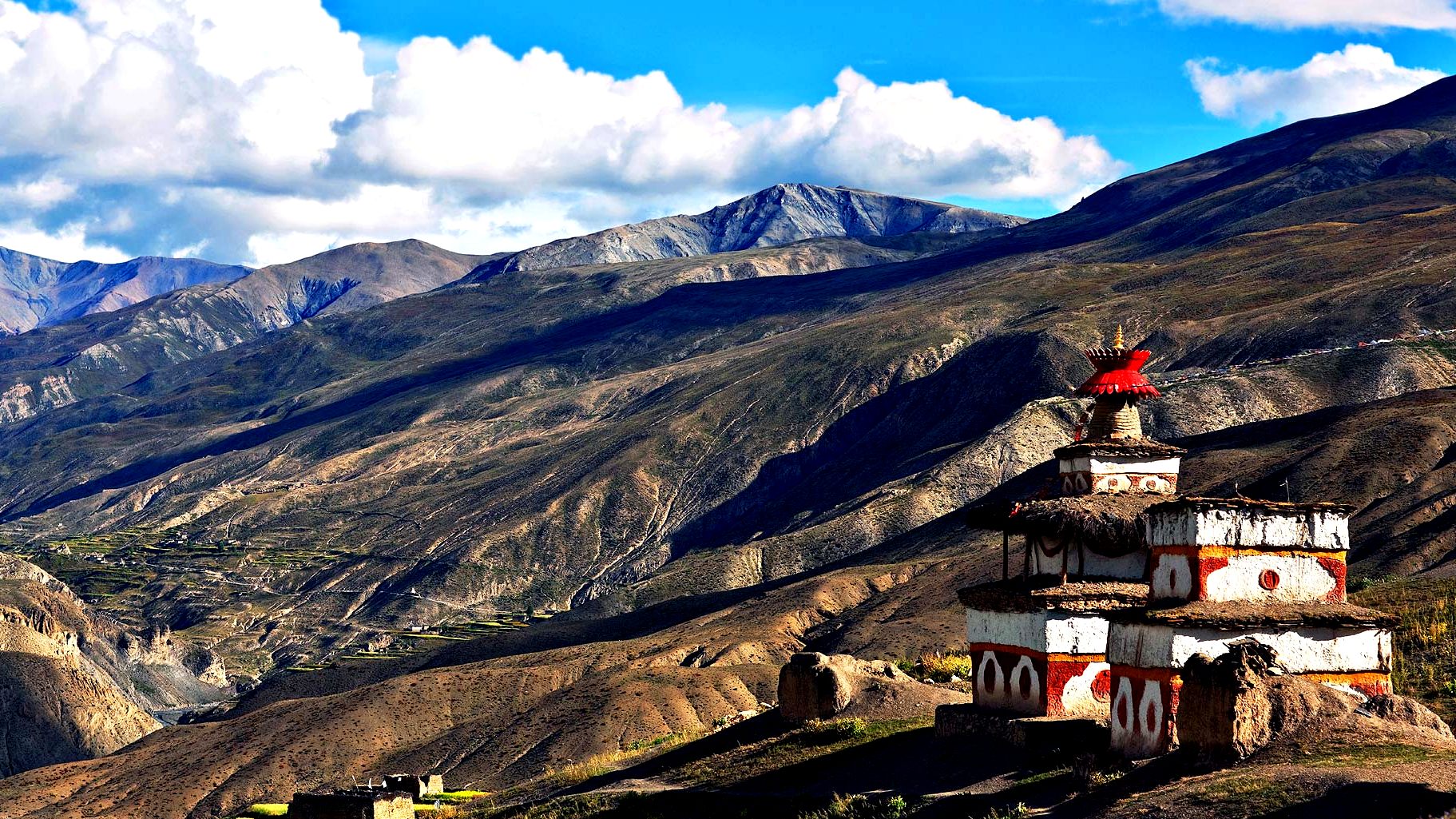
Key Highlights:
- Starting Point: The trek typically begins with a flight from Kathmandu to Nepalgunj, followed by another flight to Juphal, the trek's starting point.
- Duration: It ranges from 18 to 28 days, depending on the specific route and points of interest along the way.
- Altitude: Trekkers will navigate through various passes, with the highest being the Kang La Pass at 5,350 meters (17,552 feet).
- Route: The trek covers remote trails through Shey Phoksundo National Park, visiting the stunning Phoksundo Lake, and passing through ancient Tibetan Buddhist monasteries.
- Difficulty Level: It's considered challenging due to its length, altitude, and the remote nature of the trek. Suitable for experienced trekkers with a good level of physical fitness.
- Best Time to Visit: The optimal months for this trek are May to September, when the weather is most stable and the passes are typically free of snow.
What to Expect:
- Breathtaking Landscapes: From deep blue waters of Phoksundo Lake to towering peaks and serene valleys.
- Rich Culture: Exposure to the unique culture of the Dolpo region, influenced by Tibetan Buddhism and the ancient Bon religion.
- Rare Wildlife: Opportunities to spot indigenous wildlife, including the elusive snow leopard, in their natural habitat.
- Isolation and Serenity: Unlike more popular trekking destinations in Nepal, Upper Dolpo offers a sense of isolation and untouched natural beauty.
Preparation Tips:
- Permits: Obtain all necessary permits, as the region has restricted area status in Nepal.
- Physical Fitness: Engage in a rigorous training regimen well in advance, focusing on stamina, strength, and altitude acclimatization.
- Gear: Pack appropriate trekking gear, including high-quality boots, layers for cold weather, a sleeping bag rated for low temperatures, and navigation tools.
- Local Guide and Porter: Hiring a knowledgeable local guide and porter is crucial for navigating the challenging terrain and understanding local customs and regulations.
The Upper Dolpo Trek is a once-in-a-lifetime adventure for those drawn to the raw beauty and cultural depth of the Himalayas. It's an opportunity to step back in time, into a land that modernity has scarcely touched, and experience the profound tranquility and spiritual richness of Nepal's hidden valleys. This trek is a testament to the enduring spirit of the Himalayan people and the timeless allure of their landscapes.
Makalu Base Camp Trek
The Makalu Base Camp Trek is a remarkable journey to the base of Mount Makalu, the world's fifth highest peak, located in the eastern part of Nepal. This trek is renowned for its natural beauty, including high-altitude terrains, lush forests, and stunning landscapes, offering a unique adventure into one of the less traveled areas of the Himalayas.

Key Highlights:
- Starting Point: The adventure usually begins with a flight from Kathmandu to Tumlingtar, followed by a drive to the trek's starting point, Chichila.
- Duration: The trek can take about 16 to 22 days, depending on the chosen route and acclimatization stops.
- Altitude: The highest point of this trek is Makalu Base Camp itself, situated at an altitude of 4,870 meters (15,978 feet).
- Route: The route passes through the Makalu Barun National Park, offering trekkers a chance to experience a variety of ecosystems, from subtropical forests at lower altitudes to high-altitude alpine meadows.
- Difficulty Level: Classified as challenging due to its remote location, high altitude, and less developed trails. It's suitable for trekkers with previous high-altitude experience.
- Best Time to Visit: The most favorable times for this trek are during the spring (March to May) and autumn (September to November) seasons, featuring clear skies and moderate temperatures.
What to Expect:
- Diverse Flora and Fauna: The Makalu Barun National Park is a biodiversity hotspot, home to rare species of plants and wildlife, including the red panda and snow leopard.
- Cultural Experience: Though the region is sparsely populated, trekkers can encounter unique hill tribes and their cultures, distinct from those in other parts of Nepal.
- Stunning Scenery: Expect dramatic views of Mount Makalu, along with several other peaks over 7,000 meters. The landscapes are incredibly varied, from lush valleys to rugged rock faces and icy glaciers.
- Isolation: Unlike the more popular Everest and Annapurna treks, the Makalu Base Camp Trek offers a sense of solitude and unspoiled nature.
Preparation Tips:
- Physical Preparation: It's crucial to be in good physical condition, with several months of cardiovascular, strength, and endurance training.
- Packing Essentials: Include layered clothing, a good quality sleeping bag rated for cold temperatures, trekking poles, and a reliable map or GPS device.
- Altitude Sickness Awareness: Familiarize yourself with the symptoms of altitude sickness and carry necessary medications after consulting with a healthcare provider.
- Permits: Ensure you have all the necessary permits for the Makalu Barun National Park and the restricted areas within it.
The Makalu Base Camp Trek is an exceptional journey that promises stunning natural beauty, challenging treks, and the chance to experience the remote wilderness of Nepal. It's an adventure suited for those who seek solitude and are prepared to face the rigors of high-altitude trekking in exchange for the unparalleled beauty and tranquility of the Himalayas.
Manaslu Circuit and Nar Phu Valley Trek
The Manaslu Circuit and Nar Phu Valley Trek is an adventurous journey that combines the remote and majestic trails of the Manaslu region with the hidden wonders of the Nar Phu Valley. This trek is perfect for those who seek to explore less-trodden paths and experience the natural beauty and cultural richness of the Himalayas.
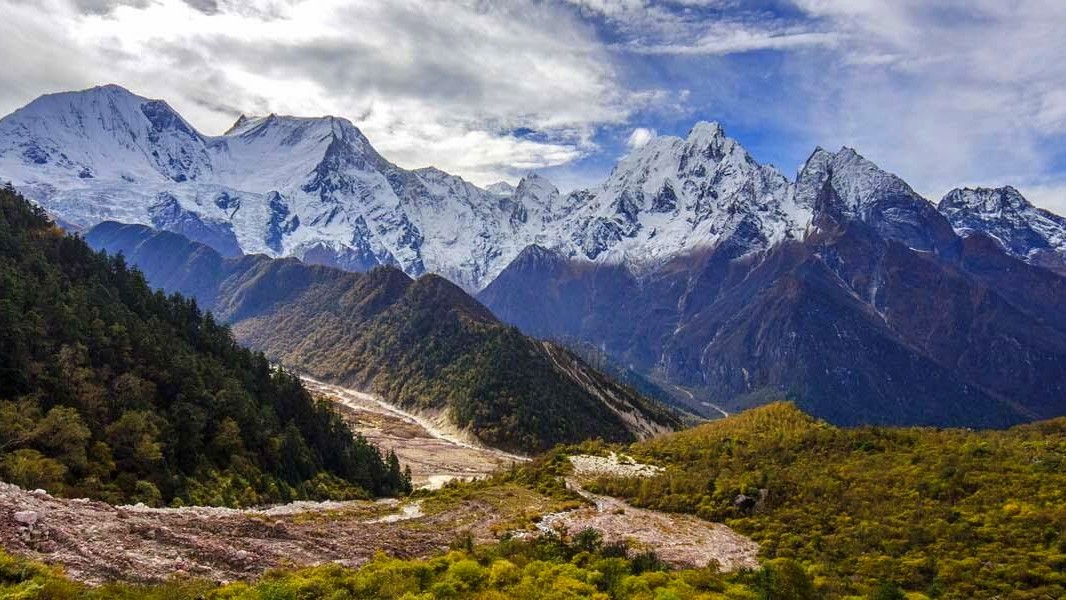
Key Highlights:
- Starting Point: The trek typically begins in Soti Khola, after a drive from Kathmandu, and ends in Besisahar, the starting point for the Annapurna Circuit.
- Duration: The combined trek usually takes about 18 to 24 days, depending on the itinerary, walking pace, and acclimatization days included.
- Altitude: The trek reaches its highest point at the Larkya La Pass (5,160 meters or 16,929 feet) in the Manaslu Circuit, and the Kang La Pass (5,320 meters or 17,450 feet) in the Nar Phu Valley.
- Route: It encircles the Manaslu massif, goes through the Larkya La Pass, and then diverts to the hidden Nar Phu Valley, offering a mix of high-altitude challenges, ancient monasteries, and stunning landscapes.
- Difficulty Level: This trek is considered challenging due to its high passes, remote location, and the need for proper acclimatization to avoid altitude sickness.
- Best Time to Visit: The best months for this trek are from March to May during the spring and from September to November during the autumn season, offering clear weather and moderate temperatures.
What to Expect:
- Spectacular Scenery: Dramatic views of Manaslu, Annapurna II, and other Himalayan giants, alongside diverse landscapes ranging from green river valleys to arid high-altitude deserts.
- Cultural Richness: A deep dive into the cultures of the Narpali and Tibetan communities, including visits to ancient monasteries, chortens, and the unique villages of Nar and Phu.
- Biodiversity: The trek passes through several conservation areas, offering chances to spot rare flora and fauna, including the elusive snow leopard in the Manaslu Conservation Area.
- Physical and Mental Challenge: Trekking through remote areas with basic facilities, crossing high-altitude passes, and dealing with the unpredictability of mountain weather.
Preparation Tips:
- Physical Fitness: Begin a fitness regime months before the trek, focusing on cardio, strength training, and hikes that simulate the trek's conditions.
- Gear and Equipment: Essential gear includes sturdy trekking boots, layers for varying temperatures, a high-quality sleeping bag, and a comprehensive first-aid kit.
- Travel Insurance: Ensure it covers high-altitude trekking, medical evacuation, and any unforeseen incidents.
- Local Guides/Porters: Hiring experienced guides and porters not only supports the local economy but also enhances safety and the overall trekking experience.
The Manaslu Circuit and Nar Phu Valley Trek is an unforgettable adventure that offers everything from breathtaking natural beauty to rich cultural encounters. It's a challenging yet rewarding journey that takes you through some of the most stunning and remote parts of the Nepalese Himalayas, promising an experience of a lifetime.
Kanchenjunga Base Camp Trek
The Kanchenjunga Base Camp Trek is a breathtaking adventure to the base of the world's third highest peak, Mount Kanchenjunga, located on the border between Nepal and India. This trek is known for its pristine beauty, remote trails, and the rich cultural experience it offers. The journey to Kanchenjunga Base Camp is less trafficked compared to other popular treks in Nepal, providing a more solitary and untouched mountain experience.
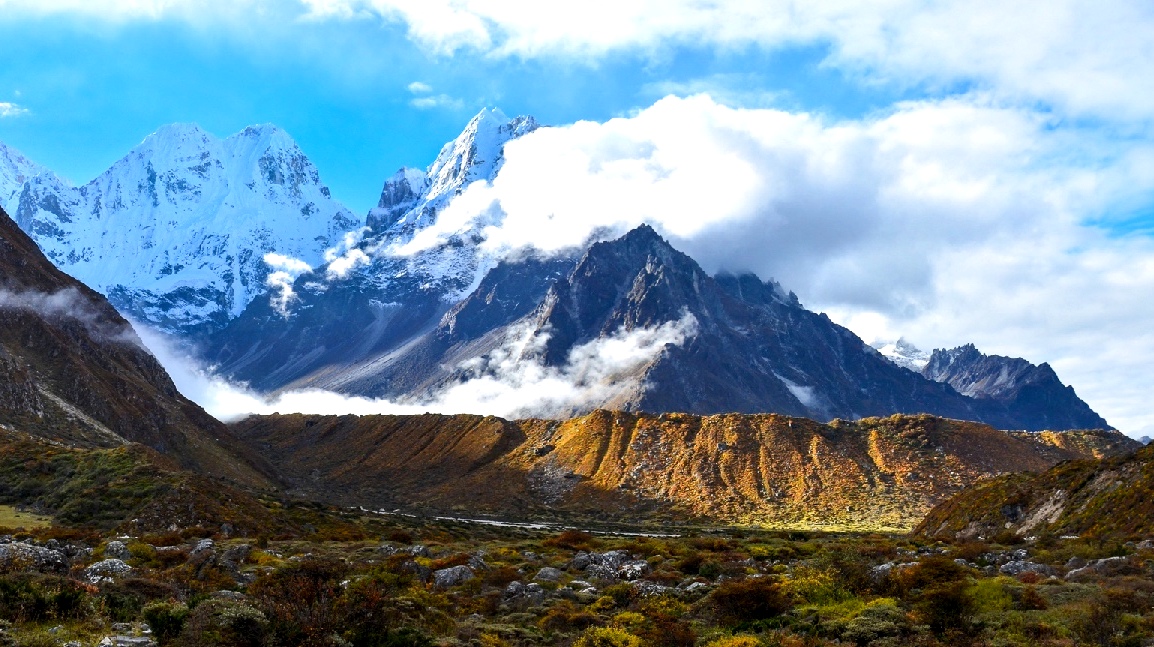
Trek Highlights
- Remote and Untouched Beauty: Kanchenjunga is noted for its remote trails that offer trekkers a pristine natural environment, far removed from the more crowded trekking routes in Nepal.
- Spectacular Mountain Views: The trek provides up-close views of Mount Kanchenjunga, along with other Himalayan giants like Mount Makalu and the Jannu.
- Rich Biodiversity: The region is part of the Kanchenjunga Conservation Area, which is home to diverse flora and fauna, including snow leopards, red pandas, and various species of birds.
- Cultural Immersion: The trek passes through several traditional villages where trekkers can experience the culture of indigenous ethnic groups such as the Limbu, Rai, and Sherpa communities.
Key Information
- Starting Point: The trek often starts with a flight from Kathmandu to Bhadrapur, followed by a lengthy drive to Taplejung, the trek's starting point.
- Duration: The duration of the trek typically ranges from 20 to 25 days, depending on the chosen itinerary and pace of trekking.
- Difficulty Level: This is considered a challenging trek due to its remote location, the altitude involved, and the length of the trek.
- Best Time to Trek: The best times to embark on the Kanchenjunga Base Camp Trek are during the spring (March to May) and autumn (September to November) months when the weather is most stable and clear.
Preparation Tips
- Acclimatization: Given the high altitudes reached during the trek, proper acclimatization days should be incorporated into the itinerary.
- Physical Fitness: A high level of physical fitness is required to complete this trek comfortably. Regular cardio, strength training, and hiking in preparation are strongly recommended.
- Gear: Essential gear includes high-quality hiking boots, thermal clothing, a down jacket, a sleeping bag rated for cold temperatures, and a first aid kit.
- Permits: Necessary permits include the Kanchenjunga Conservation Area Permit and the TIMS (Trekkers' Information Management System) card.
The Kanchenjunga Base Camp Trek is an opportunity to explore one of the Himalayas' most magnificent and untouched regions. It promises an unforgettable adventure for those who are prepared for the challenges it presents, offering a unique blend of natural beauty, cultural richness, and personal achievement.
Rolwaling Valley Trek
The Rolwaling Valley Trek is a hidden gem among Nepal's trekking destinations, offering a journey through one of the most remote and beautiful areas in the Everest region. This trek is perfect for those looking to explore off-the-beaten-path trails, with stunning landscapes, challenging terrains, and the opportunity to experience authentic Sherpa culture.
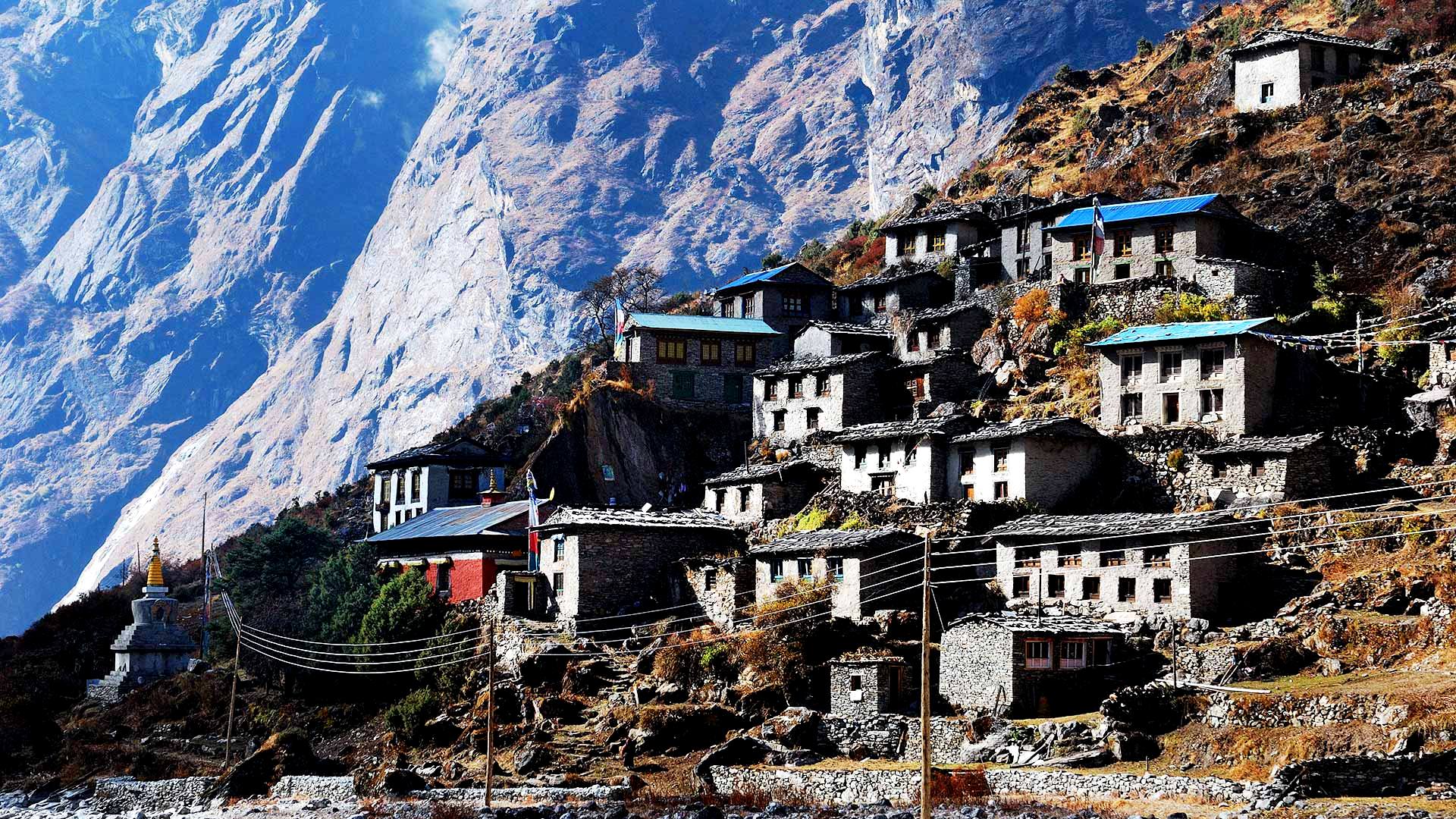
Trek Highlights
- Tso Rolpa Lake: One of the largest glacial lakes in Nepal, Tso Rolpa offers mesmerizing views and is a significant highlight of the trek.
- Rugged Terrain: The trek involves navigating through steep trails, lush forests, and high passes, including the challenging Tashi Lapcha Pass.
- Remote and Serene: Rolwaling Valley is less frequented by tourists, providing a peaceful trekking experience amidst pristine nature.
- Cultural Experience: The trek passes through several traditional Sherpa villages, where trekkers can immerse themselves in the local lifestyle and culture.
- Spectacular Mountain Views: Offers impressive views of Mt. Gaurishankar, Melungtse, and other Himalayan peaks.
Key Information
- Starting Point: The trek typically starts from Shigati after a drive from Kathmandu.
- Duration: The duration of the trek can range from 14 to 21 days, depending on the chosen route and pace.
- Difficulty Level: Considered challenging due to its high-altitude passes, remote trails, and the need for good physical fitness and trekking experience.
- Best Time to Trek: The best months for the Rolwaling Valley Trek are during the spring (March to May) and autumn (September to November) when the weather is clear and stable.
Preparation Tips
- Physical Fitness: Adequate preparation is necessary, including cardiovascular exercises, strength training, and altitude acclimatization.
- Gear and Equipment: Essential gear includes high-quality trekking boots, warm clothing, a reliable sleeping bag, and navigation tools.
- Permits: You'll need a TIMS card and permits for the Gaurishankar Conservation Area. Some parts of the trek might also require special permits due to their proximity to the Tibetan border.
- Guide or Porter: Given the trek's challenging nature and remote location, hiring a knowledgeable guide or porter is highly recommended for safety and logistical support.
Embarking on the Rolwaling Valley Trek is an adventure that offers not just physical challenges but also spiritual and cultural enrichment. It's an opportunity to disconnect from the hustle and bustle of daily life and connect with the serene and untouched beauty of the Himalayas.
Dhaulagiri Circuit Trek
The Dhaulagiri Circuit Trek is an adventurous and challenging journey around the seventh highest mountain in the world, Mount Dhaulagiri, in Nepal. This trek is renowned for its remote trails, dramatic landscapes, and the opportunity to cross high mountain passes, making it an ideal choice for experienced trekkers seeking solitude and a test of their endurance and mountaineering skills.
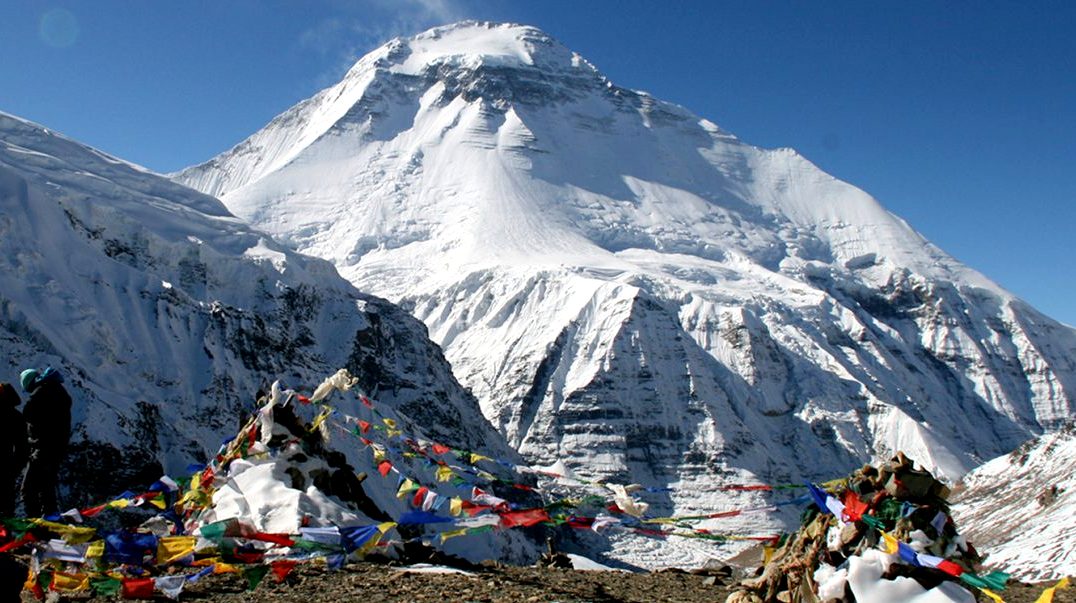
Trek Highlights
- Remote Trails: The Dhaulagiri Circuit Trek takes you through some of the most remote areas in Nepal, away from the more frequented trekking paths.
- High Mountain Passes: The trek includes crossing the challenging French Pass (5,360 meters) and Dhampus Pass (5,240 meters), offering breathtaking views of Dhaulagiri and the surrounding Himalayas.
- Glacial Traverse: A significant portion of the trek involves walking on the Dhaulagiri glacier, providing a unique mountaineering experience.
- Varied Ecosystems: The trek starts from tropical areas and ascends through various climatic zones into the arctic zone of Dhaulagiri.
- Cultural Insights: Despite being a high-altitude trek, there are opportunities to experience the lifestyles of ethnic communities living in the lower valleys.
Key Information
- Starting Point: The trek usually starts from Darbang, after a drive from Pokhara or Kathmandu.
- Duration: It typically takes around 14 to 21 days to complete the circuit, depending on the itinerary and acclimatization days.
- Difficulty Level: This trek is considered very challenging due to its high-altitude passes, glacier travel, and the need for technical climbing skills in certain sections.
- Best Time to Trek: The best times to undertake the Dhaulagiri Circuit Trek are during the pre-monsoon season (April to early June) and the post-monsoon season (late September to November), when weather conditions are more favorable.
Preparation Tips
- Physical Fitness and Training: Extensive physical preparation is required, including cardiovascular endurance, strength training, and altitude acclimatization exercises.
- Equipment: Essential gear includes mountaineering boots, crampons, ice axes, ropes, and a comprehensive first aid kit, among other high-altitude trekking equipment.
- Guides and Porters: Given the trek's difficulty and the technical skills required, hiring experienced guides and porters familiar with the route and conditions is crucial.
- Permits and Regulations: Ensure you have all necessary permits for trekking in this region, including the Annapurna Conservation Area Permit (ACAP) and the Trekkers' Information Management System (TIMS) card.
Embarking on the Dhaulagiri Circuit Trek is an opportunity to experience the raw beauty of one of the world's highest peaks up close. It's a journey that challenges both the body and the spirit, offering unparalleled rewards in the form of stunning natural beauty, a sense of accomplishment, and a deeper connection with the natural world.
Manaslu Circuit Trek
The Manaslu Circuit Trek is a stunning journey around the world's eighth highest peak, Manaslu, in Nepal. It offers trekkers a less crowded alternative to the more popular treks in Nepal while still providing breathtaking natural beauty, challenging terrains, and rich cultural experiences.

Key Highlights:
- Starting Point: The trek typically starts at Soti Khola, following a drive from Kathmandu.
- Duration: The trek can be completed in about 14 to 20 days, depending on the itinerary and pace.
- Altitude: The highest point on the trek is the Larkya La Pass at 5,106 meters (16,752 feet), providing spectacular views of Manaslu and surrounding peaks.
- Route: The circuit winds through the Budhi Gandaki river valley, ascending to alpine and then arctic environments as it crosses the Larkya La Pass before descending to the Marsyangdi river valley.
- Difficulty Level: This trek is considered challenging due to its high altitudes, remote location, and the physical demand of crossing the Larkya La Pass. It is suitable for reasonably fit trekkers with some trekking experience.
- Best Time to Visit: The best times for the Manaslu Circuit Trek are during the spring (March to May) and autumn (September to November) seasons, which offer the most stable weather conditions and clear views.
What to Expect:
- Diverse Landscapes: From lush forests and terraced hill slopes to high-altitude landscapes and the stark, stunning beauty around Larkya La Pass.
- Cultural Immersion: The trek passes through various villages home to Gurung, Magar, and Tibetan communities, offering insights into their lives and traditions.
- Flora and Fauna: The region is rich in biodiversity, including the chance to spot Himalayan Tahr, Agali (blue sheep), and even snow leopards in the conservation areas.
- Solitude: Compared to the Annapurna or Everest regions, the Manaslu Circuit is less crowded, providing a more solitary trekking experience.
Preparation Tips:
- Permits: Obtain the necessary permits for the Manaslu Conservation Area as well as a restricted area permit for Manaslu.
- Physical Fitness: Engage in cardio and endurance training several months before your trek. Include hill walks with a backpack to simulate trekking conditions.
- Equipment: Pack layers for varying temperatures, a good quality sleeping bag, waterproof gear, and sun protection. Don't forget a first-aid kit.
- Guide/Porter: Hiring a local guide and/or porter is not only mandatory but also enriches your trek with local knowledge and contributes to the local economy.
The Manaslu Circuit Trek is an incredible journey that offers everything from challenging treks and stunning natural scenery to rich cultural encounters. It's an ideal choice for adventurers looking to explore one of Nepal's hidden gems, away from the busier trails but without compromising on the majestic Himalayan experience.
Annapurna Three High Pass Trek
The Annapurna Three High Pass Trek is an exhilarating and challenging adventure that takes trekkers through some of the most stunning landscapes in the Annapurna region of Nepal. This trek is designed for those seeking to explore the high-altitude passes and the remote corners of the Annapurna Himalayas.

Trek Highlights
- Three High Passes: The trek crosses the Kang La Pass, the Mesokanto La Pass, and the Tilicho Pass, offering breathtaking views of the Annapurna range, Dhaulagiri, Manaslu, and more.
- Tilicho Lake: One of the highest lakes in the world, Tilicho Lake's mesmerizing turquoise waters are a major highlight.
- Remote Villages: The route offers the chance to visit remote villages and experience the rich culture and hospitality of the local communities.
- Varied Ecosystems: Trekkers will traverse through diverse ecosystems, from lush rhododendron forests to arid desert landscapes within the Annapurna Conservation Area.
Key Information
- Starting Point: The trek often starts in Besisahar, which is easily accessible from Kathmandu.
- Duration: The trek typically lasts about 18 to 21 days, depending on acclimatization and rest days.
- Difficulty Level: This trek is considered challenging due to its high-altitude passes, remote trails, and the physical endurance required.
- Best Time to Trek: The optimal times for undertaking this adventure are during the spring (March to May) and autumn (September to November) seasons.
Preparation Tips
- Acclimatization: Schedule adequate acclimatization days to adapt to the high altitude and reduce the risk of altitude sickness.
- Physical Fitness: A high level of physical fitness is required, with preparatory cardio, strength training, and hiking recommended.
- Packing List: Essential gear includes warm clothing, waterproof boots, sleeping bags rated for low temperatures, and a comprehensive first-aid kit.
- Permits: Ensure you have the Annapurna Conservation Area Permit (ACAP) and the Trekkers' Information Management System (TIMS) card.
Embarking on the Annapurna Three High Pass Trek offers a unique opportunity to experience the majestic beauty of the Himalayas. This trek challenges trekkers physically and mentally but rewards them with unparalleled views, diverse ecosystems, and rich cultural interactions. It's a must-do for avid trekkers seeking the thrill of high-altitude Himalayan adventures.
Gokyo Ri Trek
The Gokyo Ri Trek is a breathtaking adventure in the Everest region that offers a unique alternative to the traditional Everest Base Camp trek. This journey leads trekkers through the heart of the Khumbu region, presenting an unparalleled view of the majestic Himalayan peaks and the serene Gokyo Lakes.

Trek Highlights
- Gokyo Lakes: The trek features the stunning Gokyo Lakes, a series of six turquoise glacial lakes, which are among the highest freshwater lakes in the world.
- Gokyo Ri: Climbing Gokyo Ri (5,357 meters) provides trekkers with panoramic views of Everest, Lhotse, Makalu, and Cho Oyu, among others.
- Ngozumpa Glacier: Trekkers will cross the Ngozumpa Glacier, the longest glacier in the Himalayas, offering unique landscapes and thrilling experiences.
- Renjo La Pass: Optional routes include crossing the Renjo La Pass, which offers another vantage point for spectacular views of the Everest range.
- Flora and Fauna: The trek passes through Sagarmatha National Park, home to diverse species of flora and fauna, including the chance to spot the rare snow leopard or the Himalayan Thar.
Key Information
- Starting Point: The trek typically starts with a flight from Kathmandu to Lukla, followed by a trek to Phakding and onwards through the Khumbu region.
- Duration: The Gokyo Ri Trek can take about 12 to 15 days, depending on the itinerary, including acclimatization days and optional side trips.
- Difficulty Level: It is considered a moderate to challenging trek due to its high altitude and the physical demand of climbing Gokyo Ri.
- Best Time to Trek: The best times for this trek are during the spring (March to May) and autumn (September to November), offering clear skies and moderate weather.
Preparation Tips
- Acclimatization: Proper acclimatization days are key to avoiding altitude sickness; trekkers should include days for rest and adjustment to the altitude.
- Physical Fitness: Engaging in cardio, strength training, and endurance exercises several months prior to the trek will help prepare for the physical demands of the journey.
- Gear: Essential gear includes sturdy trekking boots, thermal layers, a down jacket, gloves, a hat, and sunglasses. Don't forget a good quality sleeping bag rated for cold temperatures.
- Permits: All trekkers need a TIMS (Trekkers' Information Management System) card and a Sagarmatha National Park permit.
Gokyo Ri Trek is an opportunity to experience the beauty and majesty of the Himalayas from a unique perspective. It offers trekkers serene natural beauty, challenging hikes, and the chance to immerse themselves in the vibrant Sherpa culture. This trek is an unforgettable adventure for those who seek to explore the less-traveled paths of the Everest region.
The Top 10 Challenging and Difficult Treks in Nepal offer adventurers the quintessential exploration experience of the Himalayas, each presenting its unique blend of breathtaking landscapes, cultural immersion, and physical endurance tests. From the serene yet rigorous paths of the Annapurna Circuit and the remote wonders of the Upper Dolpo to the iconic base camps of Everest and Kanchenjunga, these treks invite the bold to traverse ancient trails, climb high passes, and witness the untouched beauty of the world's highest peaks. As much about internal discovery as they are about external exploration, these treks challenge participants to push their limits while soaking in the rich tapestry of Nepali culture and the majestic splendor of nature. For those willing to embrace the challenges, the rewards are immeasurable—a profound sense of accomplishment and a deeper connection with the natural world.
FAQs of the Top 10 Challenging And Difficult Treks In Nepal
Q: What makes these treks challenging?
A: The challenges come from high altitudes, rugged terrains, remote locations, and the physical demands of long trekking days. These elements require a good level of fitness and acclimatization to high altitudes.
Q: Are permits required for these treks?
A: Yes, specific permits are needed for most of these treks due to their locations in protected areas or near international borders. This often includes national park permits and special trekking permits.
Q: What is the best time to undertake these treks?
A: The most favorable times are during the spring (March to May) and autumn (September to November) months. These periods typically offer clearer weather and more stable conditions for trekking.
Q: Do I need previous trekking experience?
A: Some treks are suitable for beginners with proper preparation, but others are best suited for those with previous high-altitude trekking experience due to their strenuous nature.
Q: Can I trek solo on these routes?
A: Trekking solo is not allowed on most of these routes. A minimum group size and a government-licensed guide are usually required, especially for treks in restricted areas.
Q: What should I pack?
A: Essential gear includes high-quality trekking boots, thermal clothing, a reliable sleeping bag, navigation tools, and a comprehensive first-aid kit. Preparation should also consider the specific requirements and weather conditions of the trek.
Q: How can I prepare physically?
A: Cardiovascular exercises, strength training, and altitude acclimatization exercises are recommended several months before your trek. Building endurance is key to managing the physical challenges of high-altitude trekking.
If you need any further information, please contact us by email: [email protected], Phone: +977- 985 100 5129 (WhatsApp)

